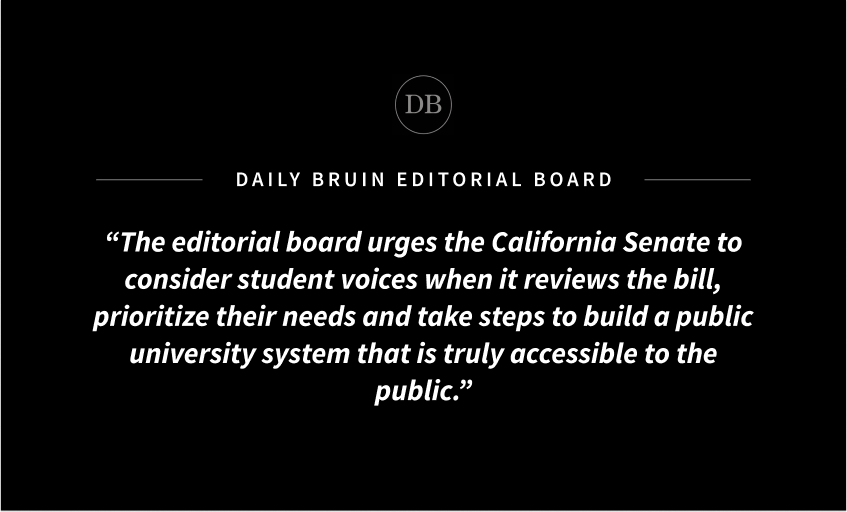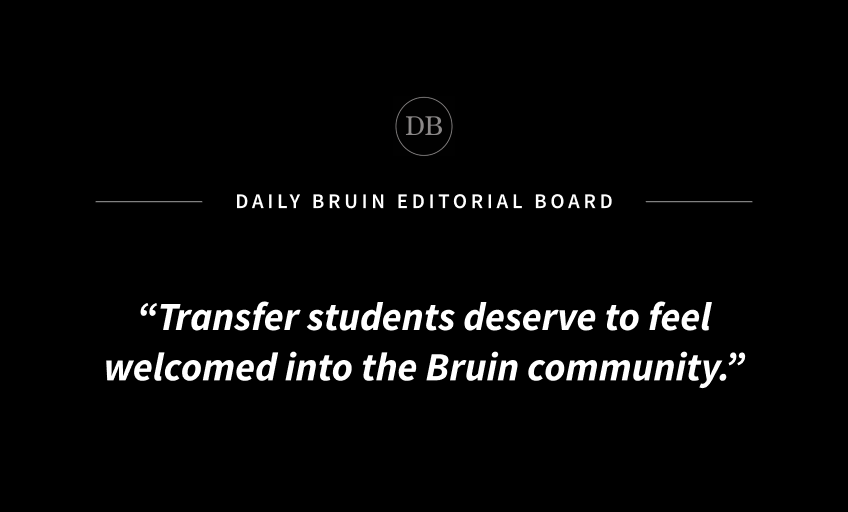Editorial: The UC should support AB 1749, prioritize transfer student needs

By Editorial Board
Sept. 1, 2023 12:30 p.m.
This post was updated Oct. 1 at 7:32 p.m.
The UC has once again demonstrated its disregard for transfer student needs.
In June, the UC Academic Senate expressed its opposition to Assembly Bill 1749, which would guarantee transfer admission into the UC system to students with an associate degree, as the California State University system already does. AB 1749 currently awaits review in the California Senate and would simplify the pathway to transfer from community colleges to four-year California public universities.
For some students, transferring can be a confusing, complicated process to navigate, especially if students have to consider requirements specific to their major or the different UC versus CSU campuses. Having to take so many requirements into consideration can lead to students enrolling in unnecessary classes that don’t ultimately count toward their bachelor’s degree, which contributes to students taking longer than four years to graduate.
AB 1749 presents an opportunity to amend an overly complex system that has long disadvantaged transfer students, who are more likely to be first-generation or low-income students than students who enroll in four-year universities directly out of high school.
The UC’s response is disappointing but unsurprising given the culture of educational gatekeeping pervading the University. The editorial board urges the California Senate to consider student voices when it reviews the bill, prioritize their needs and take steps to build a public university system that is truly accessible to the public.
If passed, AB 1749 would represent a dramatic transformation within the UC system, giving priority admission to transfer applicants who have earned an ADT – a specialized type of associate degree created to simplify the process of transferring to public universities in California – and maintained a GPA above 3.0.
Under the current system, transfer requirements are not standardized between the UCs and the CSUs. For transfer students who have earned an ADT, the CSUs guarantee admissions to one of 23 campuses, although specific campuses and majors are not necessarily guaranteed.
Additionally, ADTs also provide a degree of standardization across majors, with the CSUs ensuring that ADT recipients will only need 60 more units – 90 under the quarter system – to complete their degree and graduate.
While the lack of a guaranteed campus and major is not ideal, the CSU’s ADT programs have achieved some remarkable successes.
According to CSU enrollment data, 42% of transfer students – about 28,000 in total – at CSU campuses were accepted with an ADT during the 2019-2020 school year. Overall, 15% more students with ADTs graduated in two years and 7% more graduated in four years than transfer students with traditional associate degrees.
The program’s growth is particularly impressive because of its link to the dramatic rise in the overall number of transfer students in the CSU system, with nearly 23,000 more transfer students enrolled in 2020 than in 2012, when only 3% of CSU transfer students held ADTs.
Although some of this progress has regressed in the aftermath of the pandemic and broader demographic changes in the state, the ADT remains a key pillar of the CSU’s efforts to support its body of transfer students.
At the UCs, meanwhile, prospective transfer students must navigate a much more complex series of requirements if they want a chance at admission. Beyond the minimum requirements for transferring to the UCs, each campus has its own individual course, GPA and other criteria to be considered, including specific prerequisites for schools and majors.
Even more concerning, however, is the patchwork system of inter-school educational agreements that determine which courses are eligible and ineligible for transfer.
Reaching even the minimum requirements for transferring to a particular UC can be made even more difficult depending on which courses are deemed by the individual UCs to be eligible for credits, with transfer students needing to use tools such as the online database “Assist” to navigate the disorienting web of major-specific educational agreements between UCs, CSUs and California community colleges.
But transfer students shouldn’t have to rely on a massive database to figure out what they need to attend four-year universities.
In response to this complexity, the UC has introduced some programs to ease the transferring process, at least a little. All UCs except UCLA, UC San Diego and UC Berkeley provide guaranteed admission through the Transfer Admission Guarantee program.
On the other hand, the UC Transfer Pathways program is essentially a set of major-specific courses that, if taken, will make prospective transfer students “competitive” in the admissions process and ensure they’ve completed certain major prerequisite courses before attending classes at a UC.
Certainly, these programs – recently brought together as “Pathways+” – do have some advantages for transfer students, but they also add another set of requirements that community college students need to fulfill for their prospective major, assuming their major and desired campus are eligible for these programs to begin with.
In seeking to allegedly help transfer students get admitted to the UCs, these programs often replicate many of the same issues that the lack of standardization has brought to trying to transfer to a UC.
The impact on community college students seeking to transfer is clear. According to a report published by the Campaign for College Opportunity, only 2.5% of California community college students transfer in two years, and less than a quarter transfer in four, despite the fact that over 75% attend these colleges with the intent to transfer.
Students from underrepresented communities in particular face further barriers to transferring. Only 10% of Latino students and 9% of Black community college students transfer in four years. That compares with 27% of Asian American students and 17% of white students.
The confusing mess that is the transfer process and the difficulties that students face are inextricably linked. In a survey of 700 current and former community college students run by the outlet EdSource, nearly half of respondents said the current transfer process was not easy to understand.
In its response to the bill, the UC Academic Senate outlined a series of criticisms of AB 1749, arguing that ADTs are an inadequate fit for transfer students at the UCs, would delay graduation times for admitted transfer students and decrease campus diversity.
According to the letter, the fact that the ADT program guarantees admission based on “only GPA and a checklist of courses” will make campuses less diverse because of the close link between family income and GPA.
Importantly, there are genuine concerns about how equitable the ADT program is in the first place. The same 2021 report found that only 37% of Black students who earned associate degrees earned ADTs, highlighting the need for further resources and support for the ADT pathway at California community colleges. That compares with the 53% of Latino students, 46% of Asian American students and 44% of white students who have earned ADTs out of the total who have earned associate degrees.
But the argument that the ADT program would undermine diversity because of the role of GPA seems questionable in light of how essential GPA already is to the current admissions process.
At UCLA, for instance, the top 75% of admitted transfer students had GPAs above 3.74. The role of GPA in college admissions is certainly up for debate but it seems nonsensical to criticize the effects of AB 1749’s GPA requirements on campus diversity when the overwhelming majority of transfers need to average above an A- to be admitted under the current system.
On the other hand, when it comes to issues over the course requirements of ADTs, the call is coming from inside the house. The UCs themselves set the major requirements, which community college classes count for UC credits and, therefore, the timeline for transfer students to graduate.
Instead of maintaining separate systems that seem to only further complicate the transfer process, the UCs should instead cooperate more actively with the California community college system and the CSUs to make ADTs work for transfer students at all of California’s public universities.
For UCLA, in particular which has still refused to join TAG as admissions get more competitive with each passing year, opposition to AB 1749 is especially shameful.
Our university owes its existence today to the California State Normal School System, the predecessor of the modern CSUs, which sought to make education accessible for the people of Southern California.
It’s time to learn from the public schools that made ours possible; a brighter future for transfer students in our state hangs in the balance.





